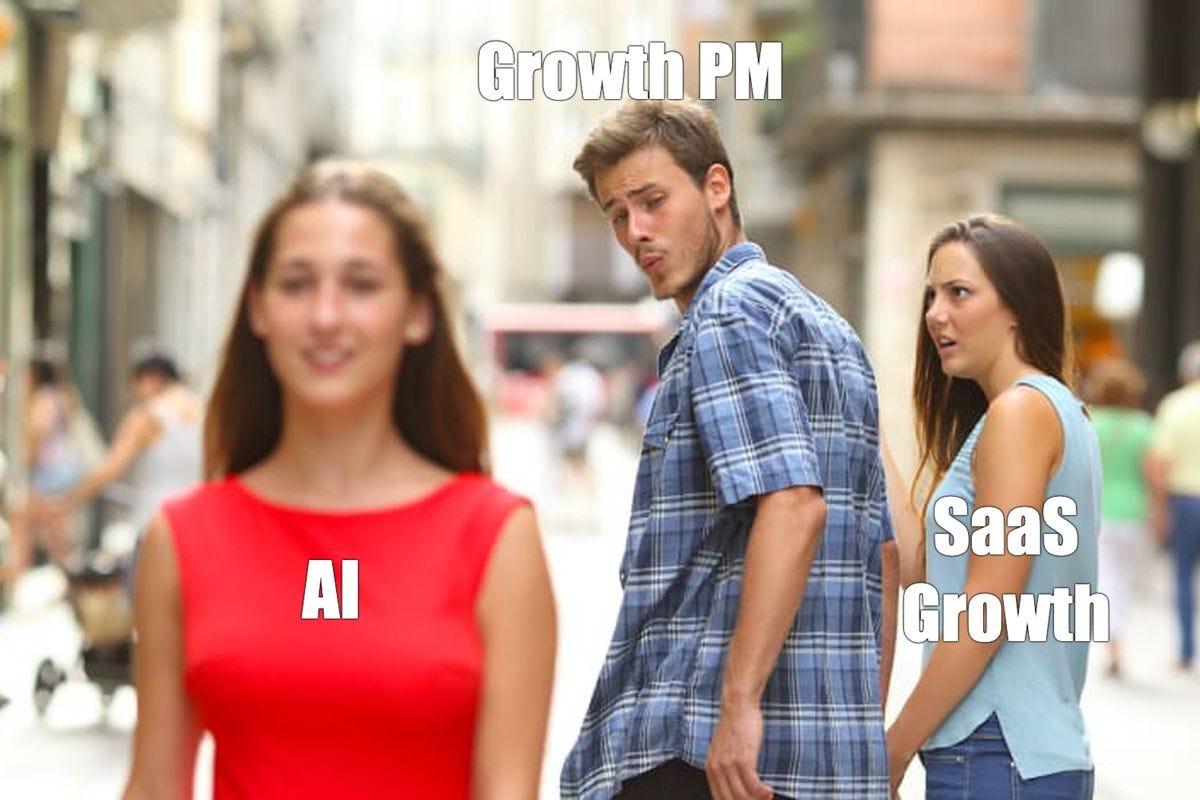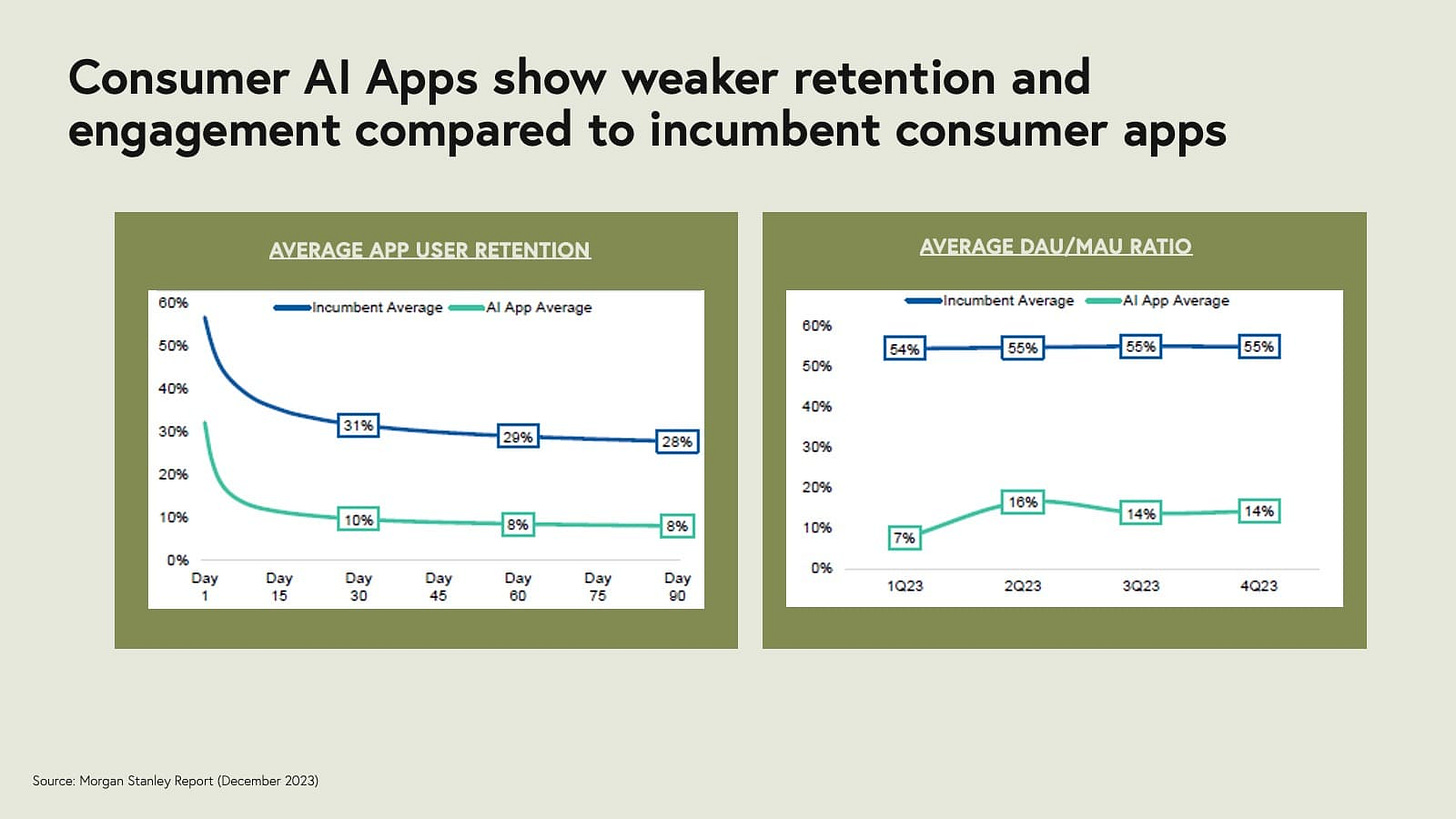AI-Native Defensibility: Why Speed Isn't Enough
How AI changes the growth funnel, and how to build moats in an era where anyone can ship in a weekend
This post is co-authored with Julia Ankudinova, CPO of BusinessMatch and Femfounders co-founder, and my partner in crime in all things AI :)
AI is changing the startup playbook as well as the growth one. The same tools that let you build faster also let your competitors catch up faster. And when competitors are already knocking at your door and eating away your customer base, speed may not save you. Built-in defensive mechanisms will.
To understand, why defensibility becomes ever more important, let’s first briefly take a look at the typical growth funnel, and how AI changes it.
How AI Changes Growth
In a lot of ways, AI flips the growth playbook on its head. It doesn't just change how and what we build — it changes customer behavior, go-to-market, and the business model.
So, what the hell is going on?
Acquisition is getting weird
For starters, for AI products, TOFU isn’t that big of a problem — the AI hype does the job for you. While curiosity doesn’t equal actual intent, it still contributes to virality. And as some say “any interest is good interest”.
Traditional channels are losing effectiveness. SEO and UGC are being partially replaced with LLMs usage. Paid ads become less predictable and more costly, (although AI does enable some personalization).
On the flip side, authenticity and human-generated content matter more than ever (you don’t miss the water till the well runs dry 🤷♀️). When every product demo looks like magic, people seek authentic voices, rawness, and truth.
Founder content, building in public, open sharing of mistakes, and AI-free community discussions are the new channels that aren't easy to hack — and this is where their value comes from.
Clay grew fast by demoing magic moments on LinkedIn. They didn't just launch quietly — they showed what B2B outreach could look like with AI. People didn't just sign up. They shared it.
Lovable turned short-form content into demand long before the product was polished. They shipped in public, built community, and positioned themselves as the brand to root for.
Today, early adoption lives at the intersection of content, product demos, and founder voice and is won long before the product is perfect.
Activation: the good, the bad, and the ugly
AI products can provide value sometimes even before the signup happens, and with as low investment as just one prompt. How cool is that?!
For companies, though, giving away immediate value isn’t free anymore. While there is an unprecedented opportunity to shorten time-to-value, it comes with a catch:
Defining what value really means, because with LLMs it’s getting way more subjective. Sometimes a simple text output is enough, other times a complex interactions doesn’t get to value. Traditional activation metrics no longer predict success definitively.
AI hype has created “AI tourism” when a user visits a product, uses the free 5 tokens to see what it’s about, then leaves to never remember about it.
So predictability of activation is diminishing, while the costs to service the “try-before-you-buy” model are getting quite tangible.
Retention is the real challenge 🥲
Many AI products excel at solving one Job-to-be-done incredibly well. This makes sense given the extreme competition and complexity of training models. But this can easily jeopardize retention.
First, the question of recurring value becomes acute when your product delivers its entire value in a single(ish) interaction. Take an AI logo maker, or a document scanner, or a professional headshots creator. For the majority of non-professional users, such a need is very infrequent, and it’s easy to forget the product.
Second, without adjacent value it may be hard to create habit loops to keep people coming back.
For example, you may discover Photoroom to help you remove and swap backgrounds for your headshot in a social network. You don’t need this often. But you might continue using it more frequently for its great selection of templates and relevant editing tools for Instagram stories, LinkedIn posts, or other social formats.
Monetization is one big experiment
We’re figuring out new pricing models that can balance value and cost scalability in real-time.
Frankly, Julia and I are not too concerned about monetization — we're in the "business" business, after all, so pricing will be one of the things we'll figure out sooner rather than later. We just need a bit more time and data.
However, there are some interesting shifts happening:
The Perceived Value Shift: Customers now compare complex solutions to commoditized LLMs that feel like they provide similar value for a fraction of the price, even if it needs a little bit more work.
The Value Anchoring Puzzle: Sometimes it's not even clear (for businesses and users alike) how much the product should charge, less or more? We tapped into new problem and solution domains, creating entirely new value that may be hard to anchor to anything.
The Revenue Protection Push: There’s a more prominent shift towards annualized payments to fund retention, incentivized by substantial discounts.
Defensibility isn’t an afterthought anymore
But overcoming these hurdles is not the end!
As soon as you’ve found even a hint of Product-Market Fit, the clones arrive. Fast. The same speed that helped you build will help them clone.
AI has radically compressed the time it takes to go from idea to working product. You can stitch together a working MVP using:
Pre-trained APIs from OpenAI or Anthropic
Open-source models
No-code tools and deployment platforms like Vercel, LangChain, or Replit
Which means protecting what you've built isn't something you think about at Series B. It's something you start designing for from day one, because "good value" isn't enough when everyone can deliver good value quickly.
Inspired by a metaphor from NFX, Julia finds the Bailey and Motte framework useful for thinking about how AI startups balance fast execution with long-term defensibility.
Here’s how it applies:
The Bailey and Motte Model
In medieval settlements, the Bailey was the outer courtyard — fast to build, where daily life happened. The Motte was the stone tower on a hill — hard to build, but also hard to take and destroy.

Startups operate just like these medieval settlements:
Early wins happen in the Bailey: fast distribution, rapid growth, strong initial traction.
But the companies that last don’t just defend the courtyard. They invest in the stone tower, the Motte, while no one’s attacking.
Bailey: Win the Moment
Your Bailey is where value gets created, delivered, and exchanged.
It's tactical, "everyday" type of defensibility — the moves that help you capture and hold territory in the short term.
But the AI-native Bailey requires specific superchargers:
Speed as a competitive advantage
Speed has always mattered, but now it's existential.
For many companies, the race to integrate AI isn’t optional — it's about avoiding disruption.
Take product analytics tools: traditional manual and reactive analysis is being replaced by AI-first platforms that proactively surface insights and suggest explanations. This may be an extreme example, but it perfectly illustrates speed as a defensibility factor.
Companies that move slowly risk being left behind entirely. If not today, then tomorrow.
Brand as a tactical amplifier
Brand used to be purely a long-term play. Now it's becoming tactical— an amplifier to your distribution through emotional engagement and human connection.
In a sea of AI tools that mostly do the same thing, users ask: "Which one gets me?" and "Which one do I trust to show up the way I need?"
Each finds what resonates better with their personality:
ChatGPT feels calm, polished, helpful — a neutral assistant.
Claude feels more empathetic, thoughtful — a helpful coworker.
Perplexity feels like a straight-to-the-point researcher with receipts.
These aren't just different outputs; they're emotional signals, the "vibes" that create preference when the value is similar. Your tone, aesthetics, onboarding, human connection — all contribute to this immediate brand differentiation.
Founder's open sharings, real values, strong stance on some ideas, or building in public are brand elements that create a sense of belonging and unity (something the entire population is massively lacking these days).
Now more than ever we see that features don't win loyalty — vibes do. And when everything else looks the same, brand becomes the shortcut to trust.
Growth momentum creates unfair advantages
AI-native products can scale incredibly fast, and early momentum compounds into real advantages:
Better investors
Stronger hiring pipelines
Faster feedback loops
Often better pricing deals with model providers
‼ But speed without structure doesn't last. Which brings us to the Motte.
Motte: Moats That Compound
Your Motte represents long-term defensibility — the strategic advantages that compound over time and become harder to replicate.
Traditional moats still matter!
Network Effects
They come in two main forms:
User network effects: the more users are using the product, the better it becomes for eveyone. Social networks are a vivid example.
Data network effects: more users per se do not make the product better, but the data they bring with them does. Waze uses each user’s GPS and driving data to create a more accurate, up-to-date mao of current road conditions. Google Search improves search results as the database of queries, click patterns, and outcomes grows.
This way, products that provide better outcomes for all users the more they are used, have natural defensibility against competitors.
Data network effects are sort of inherent for AI tools. ChatGPT improves with every conversation, because every user and interaction trains it and tunes the model for future ChatGPT users, as well as all other products built on top of it.
But user network effects become even more important.
Gumloop, a multiplayer workspace for prototyping AI workflows, becomes exponentially more powerful when adopted across a team, because:
It learns from shared prompt patterns and execution history
It stores context across experiments and collaborators.
This way, Gumloop becomes a living memory of your team’s AI problem-solving — something a new tool can’t easily replicate. If one person leaves Gumloop, they lose some convenience. If an entire team leaves, they lose accumulated logic, shared iterations, and co-created workflows.
Character.ai creates AI-powered chatbots ("characters") with distinct personalities, which are then shared within the wider community. More users bring the diversity of characters.
Most popular chatbots get featured and promoted, which creates incentives for users to create higher quality or more unique characters, amplifying engagement and retention.
Suno makes user-generated AI songs discoverable, which in turn improves overall recommendation and sampling algorithm as the volume and variety of songs increases. The more unique data the user base generates, the more novel or relevant output the AI can create or recommend in the future.
Switching costs
Thinking of defensibility, it is important to ask yourself not only how easy it is to replicate your product, but also "If users were leaving my product, is there any value they would be losing?"
There are a few factors that make it harder for customers to leave your product:
Context: the tool already knows your personal or team preferences
History: past chats, drafts, actions that guide new ones
Outputs: documents, summaries, decisions — all stored and referenced
Team knowledge: shared memory across the company
Integrations: tools connected and workflows are set up and running
Trust: users know what to expect and what not to
For example, it can be easy for you to switch from one AI meeting notetaker to another if you are only using it to share recordings with people you meet.
But if you rely on a meeting assistant like Fireflies.ai to extract client data from sales calls and feed it into your CRM, or to extract insights from user research calls, you may find it hard to just switch to another solution. While it may be not as hard to move raw data due to data regulations, you’ll also have to move all your insights, context, and model fine-tuning for your org needs.
Switching costs are higher for teams, especially enterprise ones. The sheer volume of data as well as the investments in the setup, training, and integrations will not merit switching to a new software and going through all the hoops of buying, training, and adoption for companies.
But even for prosumer software switching costs matter.
The simplest example is ChatGPT or Claude that allow you to create projects with content and instructions — basically a “second brain” with memory. This creates a reliable lock-in with a model of your choice, as moving all this context can be a ton of work.
Or take Reforge AI Assistant. If you've ever written PRDs or GTM plans inside Reforge's AI, you won't be switching a tool — you'll be giving up your entire strategic context, even if you're the only one in your organization using it.
👉 But there are also AI-native defensibility factors!
Data quality and uniqueness
The source and quality of your training data can create unbeatable advantages! Proprietary and well-curated data can deliver results that commoditized models simply can't match, in the following ways:
1) Your data helps you deliver outstanding outputs compared to the quality bar from commoditized products. This is especially relevant in verticalized domains, where generic outputs simply aren't good enough.
EvenUp, a Legal AI for healthcare claims, drafts legal demand letters by using deep proprietary knowledge of how different hospitals generate their medical bills. Their system improves as it ingests more real-world, domain-specific data and edge cases — something a generic model or public data source cannot compete with in accuracy or relevance for this niche.
2) Proprietary data isn't easily replicable and accessible, so it creates a lasting differentiation. Any product built on public data can be disrupted tomorrow by a product based on the same public data.
Databook aggregates public company data and augments it with proprietary strategic account data, technographics, and custom signals from customers themselves. The result is richer, more actionable sales intelligence that competitors can't easily re-create — giving Databook a data-driven advantage in enterprise sales enablement.
3) Your data isn't just used to produce outputs (e.g., summaries, answers) but to personalize user experiences based on behavioral signals and personal preferences. This is truly hard to replicate.
A B2B mobile analytics and marketing platform, Localytics leverages behavioral, in-app engagement data from each client to tailor mobile messaging, optimize campaigns, and provide market-specific benchmarking. As more clients use the platform and generate proprietary engagement data, both their own recommendations and industry benchmarks improve, creating a data network effect.
Workflow embedding
While many AI tools may provide impressive results, oftentimes they are just add-ons to the core user workflow.
This leads to a potential risk of being disrupted by the core workflow owner. Even if they don’t provide exceptional results, they give a breadth of solutions within the problem space. This poses a risk for the exceptional point solution to lose a huge portion of their customer base overnight.
Because let’s be honest, who loves using (and paying for!) a myriad of tools with constant context switching? Remember that perceived value often means more in the heads of users than actual value.
Products that embed themselves into essential workflows become much harder to replicate. When your product becomes a core part of someone's workflow, they don't “use” it — they depend on it. This transforms standalone features into mission-critical tools that heighten switching costs.
Consider Gong, which embedded itself in sales workflows by analyzing calls and surfacing deal insights — automatically, directly in CRM tools. Replacing Gong isn’t about swapping software — it’s about retraining sales reps, losing deal history, and breaking forecasting pipelines.
Or take a very illustrative example of Grammarly acquiring Coda to provide end-to-end documentation and collaboration workflows to its customers.
Workflow embedding is probably one of the hardest to build defensibility factors as it may require significant investments into partnerships, acquisitions, or even product development.
Workflow adoption can also be taxing for users, so growing an entirely new workspaces may be a huge challenge. Take Fibery.io — they’ve grown to $1.8M revenue and 2,500 customers with just 10% churn rate. Yet their CEO openly admits the adoption struggle: "Fibery shines in more complex processes, but this makes it harder to adopt. Fibery power unfolds with time and with 20+ people using it." It took them 8 years to reach this success. Imagine how many workflow-centric platforms never made it past the adoption hurdle.
Business model
For the first time in SaaS, we're dealing with real marginal costs at scale.
It’s a pretty rapid fall from 80%+ margins to just 30%-40% for AI-powered software. Depending on the nature of your AI product’s tasks and usage intensity, you need to undersand how to intelligently balance compute costs with value scalability. This may determine whether you have enough $ fuel to keep innovating
We'll be writing more on AI-native pricing models and their implications for products and growth, so stay tuned :)
Smart unit economics becomes a competitive moat while AI startups are burning through runways on unsustainable pricing.
Building fast is easy, but sponsoring and protecting your growth isn't anymore.
Building Both Layers Simultaneously
AI gives you speed. But it gives your competitors speed too 🤓
The companies that will dominate AI-native markets won't just build fast — they'll build smart. They'll shift from getting attention to earning retention, from shipping cool features to building strategic advantages.
The key insight: you can't build Bailey first, then Motte later.
You need to be thinking about both layers from the moment you ship your first version. The earlier you start that shift, the harder it will be to catch you.
Which layer are you focusing on right now? And how soon can you start building the next?
Good luck!


